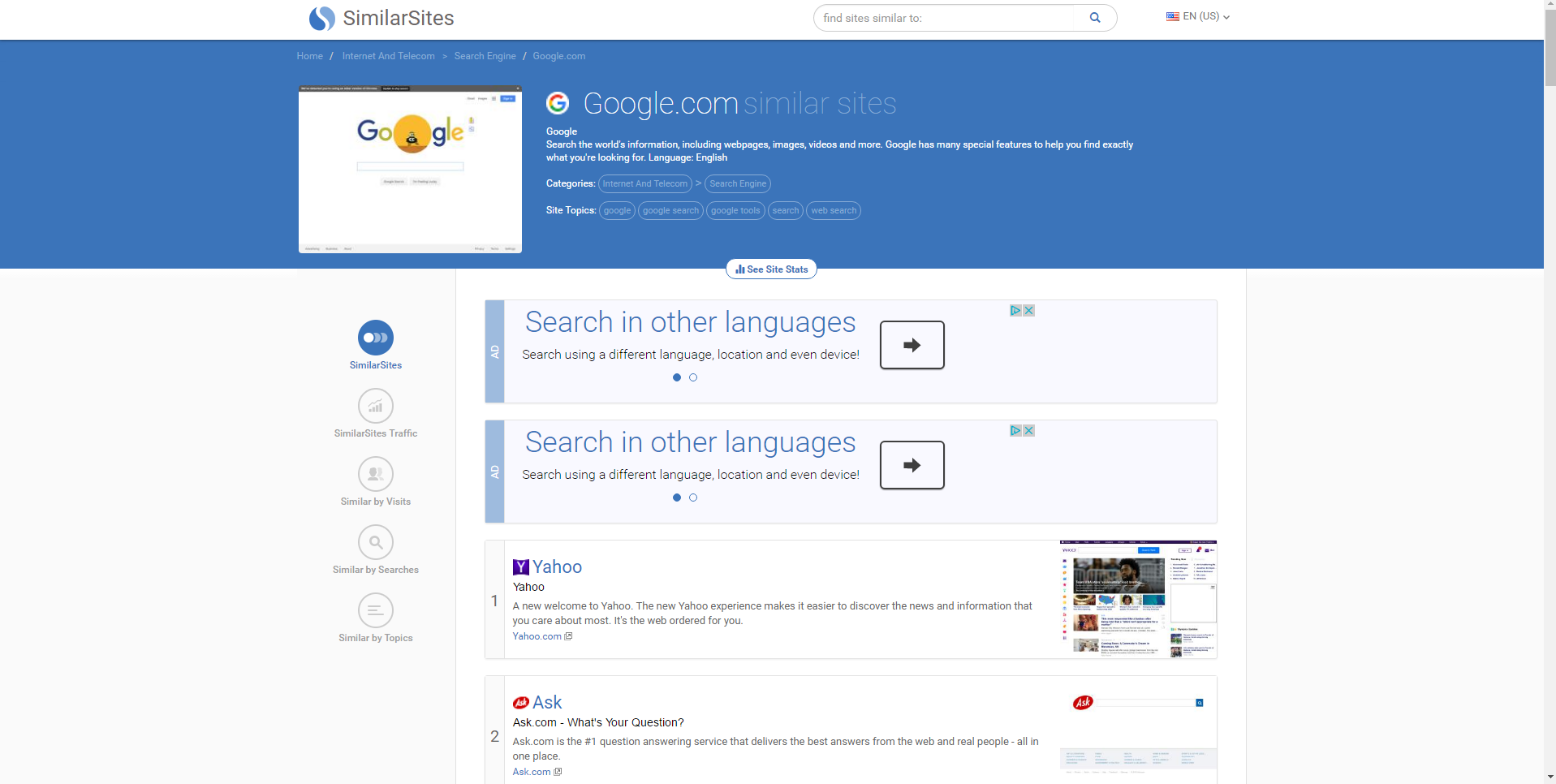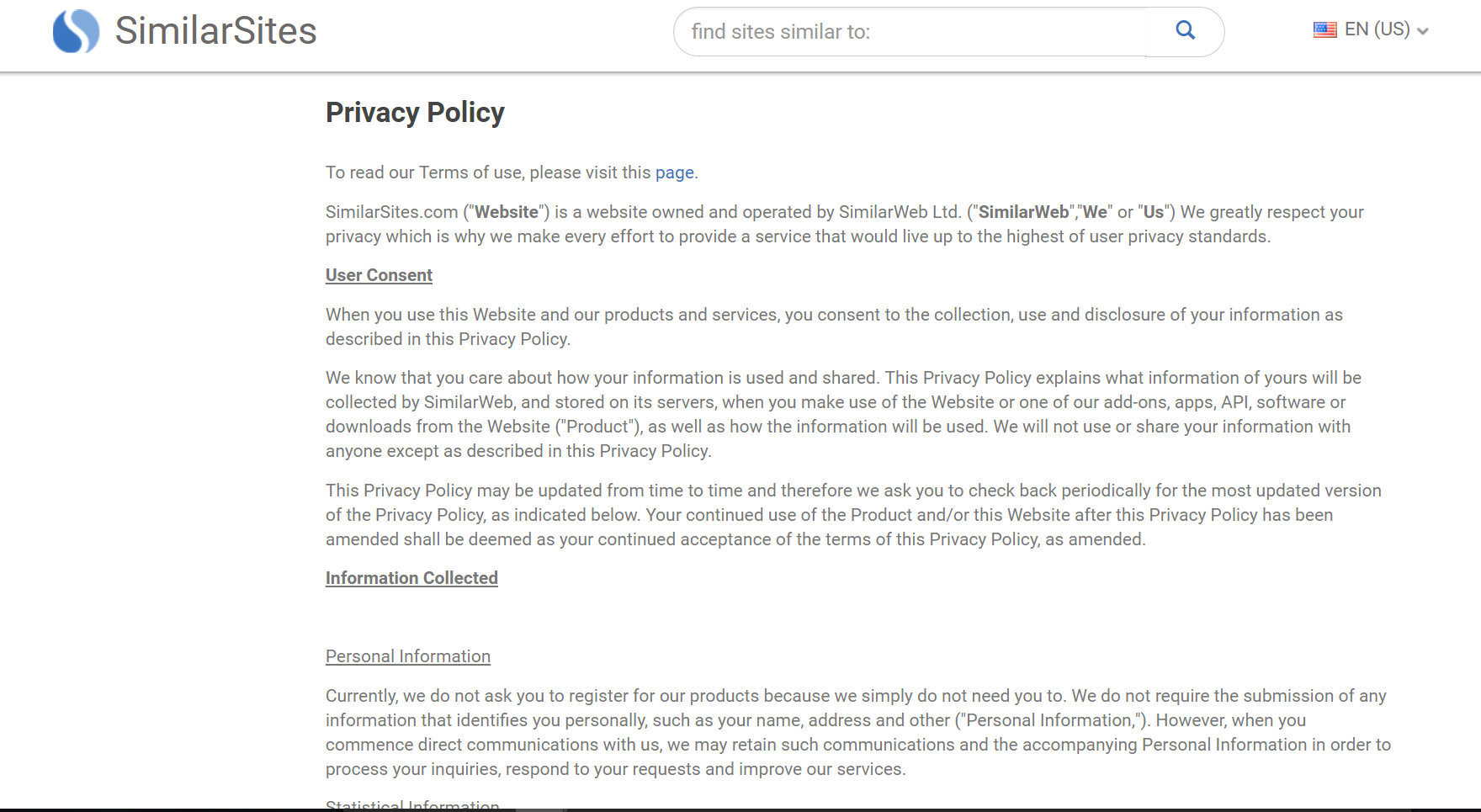Similarsites(.com) is a search engine attached to a browser hijacking software. The hijacker can add a new homepage, default search engine, and a new tab page, so it can display ads and spy on its users. Among the browsers that can be infected are Mozilla Firefox, Google Chrome, Microsoft’s Edge, Internet Explorer, and others. You can remove it with the help of this article.
| Name |
|
| Main Domain Address |
SimilarSites.Com |
| Solution #1 |
The easiest way to remove and other browser hijackers from your computer is with the help of an anti-malware tool. This software will also protect your computer from severe cyber threats like ransomware |
|
Solution #2 |
You can remove the browser hijacker by hand by carefully following all the guidelines of our step-by-step guide below. |
| Distribution |
PUPs, malicious ads, bundle packs. |
Similarsites(.com) Browser Hijacker – Distribution
A browser hijacker can get into your computer through a variety of paths, but the most common is the third-party bundle pack. It all boils down to tricking the users into installing a program they wouldn’t otherwise install. The developers put the third party bundle pack into a useful program. While users install said program, they often neglect to check the Terms of Use or the Custom and Advanced options, which contain extra programs. Among these extra programs, hides a browser hijacker.
Similarsites(.com) can also be installed by clicking on redirects on shady websites. Banners, pop-ups, and other types of ads are the usual suspects.
Similarsites(.com) Browser Hijacker – More details
The SimilarSites(.com) browser hijacker homepage looks like this:

As you can see, the site is filled with links to other sites. It’s likely that some of these are sponsored connections. The site also contains a lot of ads. The catch of using the SimilarSites(.com) domain is that if you enter a store, or any other domain, SimilarSites(.com) will know about it. In fact, the site can get to know you quite well if you use it, as it collects quite a lot of information. Their Privacy Policy discloses the data gathering, as you can see in the picture down below.

Information that can be collected includes:
- Personal Information about you, extracted from your searches
- The ads you’re viewing
- Your IP address
- Your Browser type
- Search inquiries
- How much time you’ve spent on a site
- Your Location
- Your domain type
So, let’s recap. The Similarsites(.com) uses methods of distribution that are shady at best, makes unwanted changes to your favorite browsing program and it spies on you while you’re using it. Does that sound like a site you’d want as your homepage? If the answer is negative, as it should be, then you must remove Similarsites(.com) from your computer permanently.
Similarsites(.com) – How To Remove It?
Luckily, Similarsites(.com) isn’t that hard to remove, though it can be tricky for people without the proper know-how. You can remove it by erasing all its files. We have provided a tutorial that will tell guide you through the process, step-by-step. You can also download an anti-malware tool, a program that will do the job for you and keep your system secure from this type of threat.
How to Enter Safe Mode
Booting Into Safe Mode in the Windows XP, Vista, 7 operating systems
- Unplug devices such as USB flash drives, Memory Sticks, DVD’s, CD’s, anything that can be bootable
- Now you have to decide which of the following methods is right for your computer. If you have:
- –One operating system on your PC, then press F8 repeatedly when you see the first boot screen after restarting your computer. If the Windows logo appears, repeat the same action until you enter the
–Multiple operating systems on your computer. This is very similar to booting with a single operating system. Press F8 repeatedly when you see the first boot screen. You just have to use the arrow keys to choose which system you should boot. - When the Advanced Boot Options appear, you should select the Safe Mode option with the arrow keys. Confirm the selection by pressing Enter
- Log into your computer using the Administrator account
While you’re in safe mode, your screen will be windowed.
Booting into Safe Mode on the Windows 8, 8.1, and 10 Operating Systems
- Open the Start menu
- Hold down the Shift button and left-click on the Power icon, then click Restart
- After the reboot, the Startup menu will appear. From there, choose Troubleshoot
- From the Troubleshoot menu choose Advanced Options
- Once you’re in Advanced Options, click on Startup Settings
- Click Restart
- A menu should appear after the reboot. Choose Safe Mode by pressing its corresponding key number. The PC will restart and boot into Safe Mode.
Remove/Uninstall SimilarSites(.Com)from Windows
Here’s a way to remove the program. This method will work regardless if you’re on Windows 10, 8, 7, Vista or XP. Simply selecting the program and pressing delete won’t work, as it’ll leave a lot of small files. That’s bad because these leftovers can linger on and cause all sorts of problems. The best way to delete a program is to Uninstall it. Here’s how you can do that:
- Hold the “Windows” button (It’s between CTRL and Alt on most keyboards) and press “R.” You’ll see a pop-up window
- In the textbox, type “appwiz.cpl”, then press “Enter.”
- The “Programs and features” menu should now appear. It’s a list of all the programs installed on the PC. Here you can find the program, select it, and press Uninstall.
Follow these instructions and you’ll be able to uninstall it successfully.
How to Remove SimilarSites(.Com)from Your Browser
Before resetting your browser’s settings, you should know that this action will wipe out all your recorded usernames, passwords, and other types of data. Make sure to save them in some way
Internet Explorer
- Start Internet Explorer
- Go to the Tools menu and click on Manage add-ons.
- In the Manage add-ons window, bellow Add-on Types, select Toolbars and Extensions
- If you see a suspicious toolbar, select it and click Disable
- In Manage Add-ons window, in Add-on Types, Select Search Providers
- Chose a search engine and click Set as default
- Select the unknown search engine and click Remove and Close
- Open the Tools menu, select Internet Options
- In the General tab, in Home page, enter your preferred page
- Click Apply and OK
- On the desktop, right-click on Internet Explorer icon and select Properties
- In the Properties window, under the Shortcut tab, in Target delete the text after iexplore.exe
- Click Apply, click OK to save
- Click Close
- Start Google Chrome
- On the upper-right corner, there a Customize and Control Google Chrome menu icon. Click on it, then click on Settings
- Click Extension under Chrome
- In the Extensions menu, click on the unknown extensions, then click on the trash bin icon
- Under Chrome, Click on Settings
- In Settings, under on Startup click Set pages
- In the Startup pages menu, select the suspicious entries and click on X
- Click OK
- In Settings, under Appearance select the Show home button and click Change
- In the Home page menu, click Use New Tab page and press OK
- In the Settings window under Search, click on Manage search engines
- Once you enter Search engines, select your search engine of choice and click Make default
- In the default search settings list, find the unknown search engine and click on X
- Click Done
- Start Mozilla Firefox
- In the upper right corner, click on the Open menu icon and select Add-ons
- Inside the Add-ons Manager select Extensions
- Search the list of extensions for suspicious entries. If you find any, select them and click Disable
- Click on the Open menu icon, then click Options
- In the Options window, under General tab, Click Restore to Default
- Click OK
- In the Firefox window, right next to the URL field, click the down arrow icon. Select Manage Search Engines
- In Manage Search Engines List window, select the unknown search engine and press Remove
- Click OK



